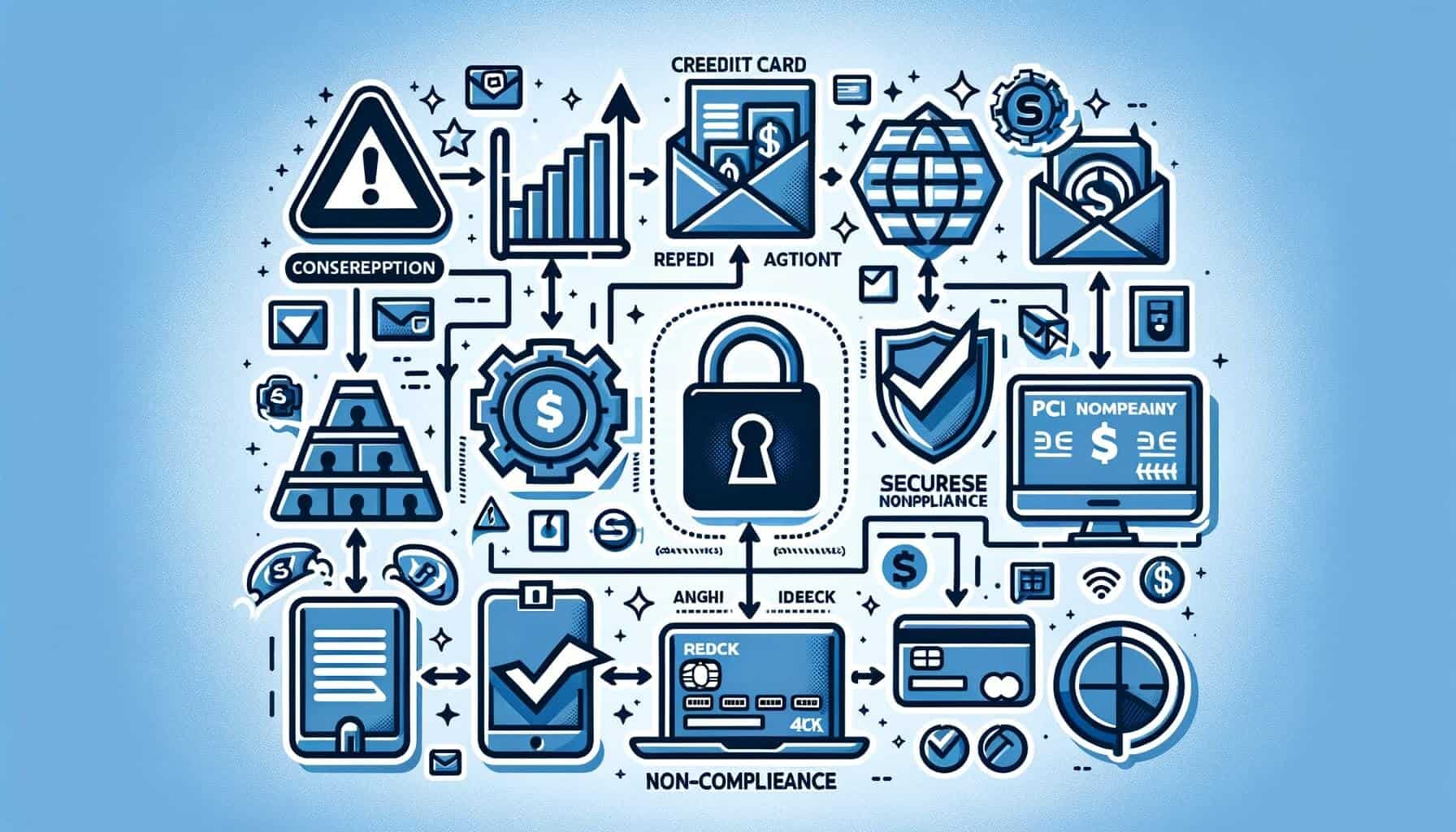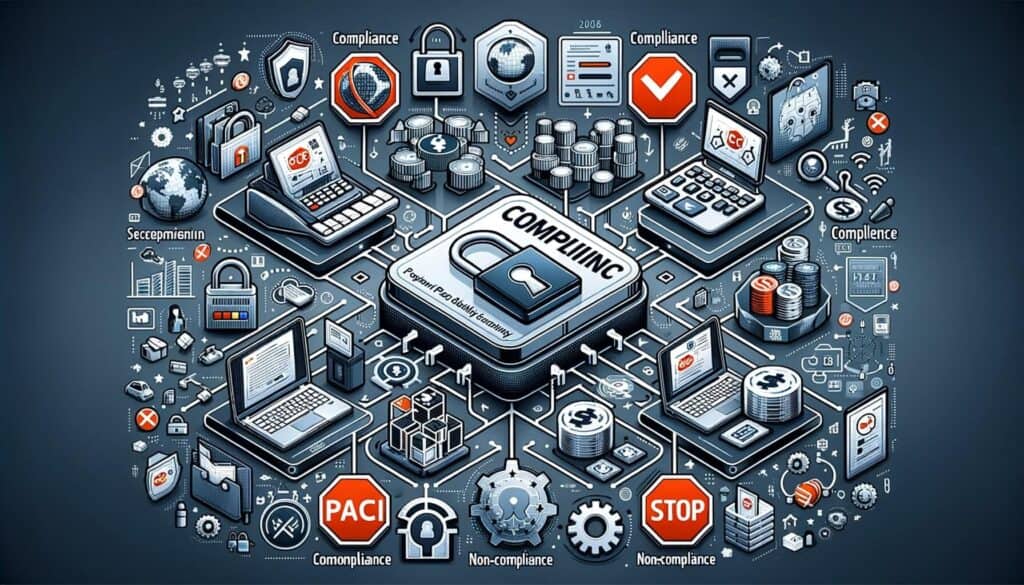
By Mollie Mills April 26, 2025
In today’s digital age, businesses are increasingly relying on electronic payment systems to process transactions. With this increased reliance comes the need for robust security measures to protect sensitive customer data. The Payment Card Industry Data Security Standard (PCI DSS) was established to ensure that businesses handling credit card information maintain a secure environment. Failure to comply with these standards can result in hefty fines and penalties known as PCI non-compliance fees.
In this comprehensive guide, we will explore the importance of PCI compliance, the consequences of non-compliance, and provide a step-by-step approach to achieving and maintaining compliance.
Understanding PCI Compliance and Non-Compliance

PCI compliance refers to the adherence to a set of security standards established by the major credit card companies, including Visa, Mastercard, and American Express. These standards are designed to protect cardholder data and prevent fraud. Compliance is mandatory for any business that accepts credit card payments, regardless of its size or industry.
Non-compliance occurs when a business fails to meet the requirements set forth by the PCI DSS. This can happen due to a variety of reasons, including inadequate security measures, failure to conduct regular security assessments, or improper handling of cardholder data. Non-compliance puts both the business and its customers at risk of data breaches and financial losses.
The Consequences of PCI Non-Compliance

The consequences of PCI non-compliance can be severe, both financially and reputationally. The major credit card companies have the authority to impose fines on businesses that fail to comply with the PCI DSS. These fines can range from a few hundred dollars to several thousand dollars per month, depending on the severity of the non-compliance.
In addition to financial penalties, non-compliant businesses may also face legal action from customers whose data has been compromised. Data breaches can result in identity theft, fraudulent transactions, and other forms of financial loss for customers. The negative publicity and loss of trust that accompany a data breach can have long-lasting effects on a business’s reputation and customer loyalty.
Assessing Your Business’s PCI Compliance Status

Before taking steps to achieve and maintain PCI compliance, it is essential to assess your business’s current compliance status. This involves evaluating your existing security measures, policies, and procedures to identify any gaps or areas of non-compliance. Here are some key steps to assess your business’s PCI compliance status:
1. Review the PCI DSS Requirements: Familiarize yourself with the specific requirements outlined in the PCI DSS. These requirements cover areas such as network security, access control, and encryption of cardholder data.
2. Conduct a Self-Assessment Questionnaire (SAQ): The PCI Security Standards Council provides a self-assessment questionnaire that businesses can use to evaluate their compliance status. The SAQ consists of a series of yes-or-no questions that assess your business’s adherence to each requirement of the PCI DSS.
3. Perform a Vulnerability Scan: A vulnerability scan is a process that identifies potential security vulnerabilities in your network and systems. This scan should be conducted by an approved scanning vendor (ASV) and is required for businesses that process a large volume of transactions.
4. Engage a Qualified Security Assessor (QSA): For businesses that process a significant number of transactions or have complex security requirements, it may be necessary to engage a QSA to perform a comprehensive assessment of your compliance status. A QSA is a certified professional who can provide expert guidance and validation of your compliance efforts.
Steps to Achieve and Maintain PCI Compliance

Achieving and maintaining PCI compliance requires a proactive approach to security and ongoing monitoring of your systems. Here are the key steps to follow:
1. Understand Your Compliance Level: The PCI DSS categorizes businesses into different levels based on their transaction volume. Understanding your compliance level will help determine the specific requirements you need to meet.
2. Build a Secure Network: Implement robust network security measures, such as firewalls, intrusion detection systems, and secure Wi-Fi networks. Regularly update and patch your systems to address any known vulnerabilities.
3. Protect Cardholder Data: Encrypt cardholder data both in transit and at rest. Implement strong access controls and restrict access to cardholder data on a need-to-know basis. Regularly test and monitor your systems to ensure data security.
4. Maintain a Vulnerability Management Program: Conduct regular vulnerability scans and penetration tests to identify and address any security weaknesses. Keep your systems up to date with the latest security patches and updates.
5. Implement Strong Access Controls: Restrict access to cardholder data to only those employees who need it to perform their job responsibilities. Use unique user IDs and strong passwords, and regularly review and update user access privileges.
6. Regularly Monitor and Test Your Systems: Implement a robust system for monitoring and logging all access to cardholder data. Regularly review these logs for any suspicious activity and conduct periodic security testing to identify and address vulnerabilities.
7. Maintain an Information Security Policy: Develop and maintain a comprehensive information security policy that outlines your organization’s approach to data security. Regularly train employees on security best practices and ensure they understand their roles and responsibilities.
Common Mistakes that Lead to Non-Compliance
Achieving and maintaining PCI compliance can be challenging, especially for businesses with limited resources or expertise in data security. Here are some common mistakes that can lead to non-compliance:
1. Ignoring Updates and Patches: Failure to regularly update and patch your systems can leave them vulnerable to known security vulnerabilities. Stay up to date with the latest security patches and updates provided by your software vendors.
2. Weak Passwords and Access Controls: Using weak passwords or failing to implement strong access controls can make it easier for unauthorized individuals to gain access to cardholder data. Enforce strong password policies and regularly review and update user access privileges.
3. Inadequate Employee Training: Employees play a crucial role in maintaining data security. Failure to provide adequate training on security best practices can lead to unintentional non-compliance. Regularly train employees on security policies and procedures and ensure they understand their responsibilities.
4. Lack of Regular Security Assessments: Conducting regular security assessments, such as vulnerability scans and penetration tests, is essential to identify and address any security weaknesses. Failure to perform these assessments can leave your systems vulnerable to attacks.
5. Improper Handling of Cardholder Data: Mishandling cardholder data, such as storing it in unencrypted formats or transmitting it over insecure networks, can lead to non-compliance. Implement strong encryption measures and ensure that cardholder data is only transmitted over secure channels.
Best Practices for Avoiding PCI Non-Compliance Fees
To avoid PCI non-compliance fees and maintain a secure payment environment, businesses should follow these best practices:
1. Stay Informed: Stay up to date with the latest PCI DSS requirements and any changes or updates issued by the PCI Security Standards Council. Regularly review the PCI DSS documentation and attend industry conferences or webinars to stay informed about best practices.
2. Implement a Risk Management Program: Develop a comprehensive risk management program that identifies potential security risks and outlines strategies for mitigating them. Regularly review and update this program to address emerging threats and vulnerabilities.
3. Engage a Qualified Security Assessor (QSA): For businesses with complex security requirements, engaging a QSA can provide expert guidance and validation of your compliance efforts. A QSA can help identify any gaps in your security measures and recommend appropriate solutions.
4. Regularly Train Employees: Provide regular training to employees on security best practices, including how to handle cardholder data securely. Ensure that employees understand their roles and responsibilities in maintaining data security.
5. Conduct Regular Security Assessments: Regularly conduct vulnerability scans, penetration tests, and other security assessments to identify and address any vulnerabilities in your systems. Implement a process for regularly reviewing and updating your security measures based on the findings of these assessments.
6. Encrypt Cardholder Data: Implement strong encryption measures to protect cardholder data both in transit and at rest. Use industry-standard encryption algorithms and ensure that encryption keys are securely managed.
7. Monitor and Log Access to Cardholder Data: Implement a robust system for monitoring and logging all access to cardholder data. Regularly review these logs for any suspicious activity and investigate any anomalies promptly.
Choosing the Right Payment Processor for PCI Compliance
Selecting the right payment processor is crucial for maintaining PCI compliance. Here are some factors to consider when choosing a payment processor:
1. PCI Compliance: Ensure that the payment processor is PCI compliant and adheres to the latest security standards. Request documentation or certifications to verify their compliance status.
2. Data Security Measures: Inquire about the payment processor’s data security measures, such as encryption protocols, secure transmission channels, and access controls. Choose a processor that employs robust security measures to protect cardholder data.
3. Compliance Support: Look for a payment processor that offers support and guidance in achieving and maintaining PCI compliance. They should provide resources, documentation, and assistance in implementing security measures.
4. Reporting and Monitoring: Choose a payment processor that provides robust reporting and monitoring tools to help you track and manage your compliance status. These tools should allow you to monitor transactions, detect anomalies, and generate compliance reports.
5. Reputation and Reviews: Research the payment processor’s reputation and read reviews from other businesses that have used their services. Look for positive feedback regarding their security measures and compliance support.
Frequently Asked Questions about PCI Non-Compliance Fees
Q1. What are PCI non-compliance fees?
A1. PCI non-compliance fees are penalties imposed by the major credit card companies on businesses that fail to comply with the PCI DSS. These fees can range from a few hundred dollars to several thousand dollars per month.
Q2. How can I assess my business’s PCI compliance status?
A2. You can assess your business’s PCI compliance status by reviewing the PCI DSS requirements, conducting a self-assessment questionnaire (SAQ), performing a vulnerability scan, and engaging a qualified security assessor (QSA) if necessary.
Q3. What are the consequences of PCI non-compliance?
A3. The consequences of PCI non-compliance can include financial penalties, legal action from customers, negative publicity, and loss of customer trust and loyalty.
Q4. How can I avoid PCI non-compliance fees?
A4. To avoid PCI non-compliance fees, businesses should implement strong security measures, regularly assess their compliance status, train employees on security best practices, and choose a payment processor that supports PCI compliance.
Q5. What are some common mistakes that lead to non-compliance?
A5. Common mistakes that can lead to non-compliance include ignoring updates and patches, weak passwords and access controls, inadequate employee training, lack of regular security assessments, and improper handling of cardholder data.
Conclusion
Achieving and maintaining PCI compliance is essential for businesses that handle credit card information. Non-compliance can result in significant financial penalties, legal action, and reputational damage.
By understanding the requirements of the PCI DSS, regularly assessing compliance status, implementing robust security measures, and choosing the right payment processor, businesses can avoid non-compliance fees and maintain a secure payment environment. Remember, protecting customer data is not only a legal requirement but also a crucial step in building trust and loyalty with your customers.